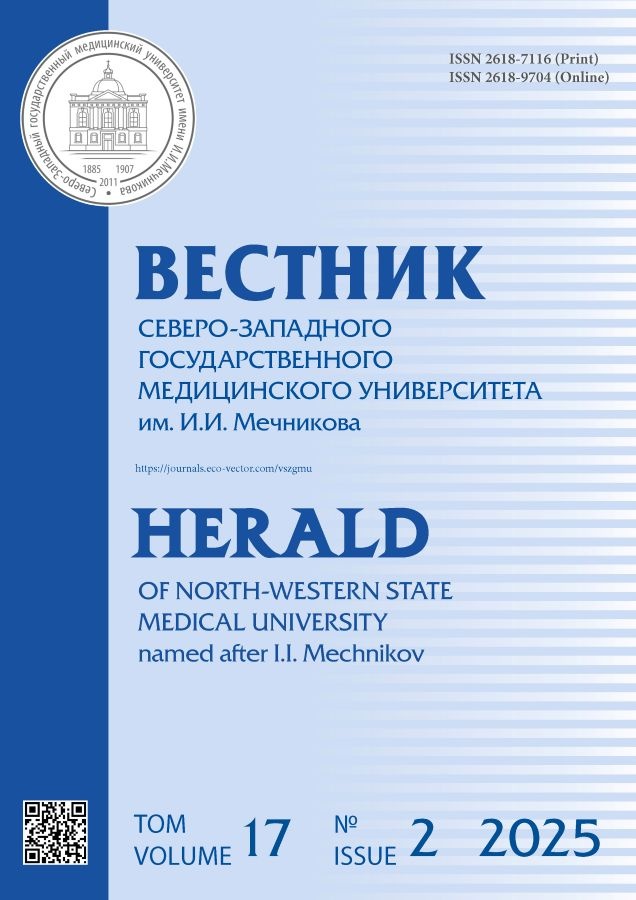Metachronous development of Hodgkin’s lymphoma and nodal marginal zone lymphoma in a patient with Sjögren’s syndrome: a case report
- Authors: Diakonova M.N.1, Pavlyuchenko E.S.1, Mirsaitov A.A.1, Byrsan R.Y.1, Leenman E.E.1, Bekhtereva I.A.1, Liz E.A.1, Mazurov V.I.1
-
Affiliations:
- North-West State Medical University named after I.I. Mechnikov
- Issue: Vol 17, No 2 (2025)
- Pages: 114-121
- Section: Case report
- Submitted: 04.10.2024
- Accepted: 23.05.2025
- Published: 30.06.2025
- URL: https://journals.eco-vector.com/vszgmu/article/view/636448
- DOI: https://doi.org/10.17816/mechnikov636448
- EDN: https://elibrary.ru/RHPTDE
- ID: 636448
Cite item
Abstract
According to various population-based studies, lymphoproliferative disorders develop 2–10 times more frequently in individuals with autoimmune pathology compared to the general population. Patients with Sjögren's disease/syndrome exhibit 10–44 times increased risk of lymphoma development compared to the general population. This predisposition is primarily driven by chronic B-cell stimulation from autoantigens produced by exocrine glands and other organs. However, no clear therapeutic guidelines for the management of these patients have been published.
This report presents a unique case of metachronous development of Hodgkin's lymphoma and nodal marginal zone lymphoma in a patient with Sjögren’s syndrome. The diagnostic workup is described in detail, including histopathological and immunohistochemical findings as well as imaging studies, along with the therapeutic approaches employed. The main difficulty in treatment was the alternation of recurrent course of lymphomas amid immunological dysregulation and autoaggression aggravated by checkpoint inhibitors, especially immune damage to the liver. The issue of the formation of an optimal therapeutic approach in this category of patients is raised in this article. The article examines the relationship between autoimmune pathology and lymphoproliferative disorders, addressing fundamental questions about the primacy of pathological processes and the development of optimal diagnostic and therapeutic approaches for this patient category.
Full Text
About the authors
Mariia N. Diakonova
North-West State Medical University named after I.I. Mechnikov
Email: dec.dmn@gmail.com
ORCID iD: 0009-0005-7514-5647
SPIN-code: 9270-6781
MD
Russian Federation, Saint PetersburgElena S. Pavlyuchenko
North-West State Medical University named after I.I. Mechnikov
Author for correspondence.
Email: Elena.Pavlyuchenko@szgmu.ru
ORCID iD: 0000-0001-7196-7866
SPIN-code: 7123-1626
MD
Russian Federation, 41 Kirochnaya St., Saint Petersburg, 191015Aleksandr A. Mirsaitov
North-West State Medical University named after I.I. Mechnikov
Email: aleksandr.mirsaitov@gmail.com
ORCID iD: 0000-0001-9204-6441
SPIN-code: 7708-5592
MD
Russian Federation, Saint PetersburgRoman Ya. Byrsan
North-West State Medical University named after I.I. Mechnikov
Email: byrsanroma@mail.ru
ORCID iD: 0009-0000-7665-2011
MD
Russian Federation, Saint PetersburgElena E. Leenman
North-West State Medical University named after I.I. Mechnikov
Email: Elena.Leenman@szgmu.ru
ORCID iD: 0009-0005-0363-9197
MD, Cand. Sci. (Medicine)
Russian Federation, Saint PetersburgIrina A. Bekhtereva
North-West State Medical University named after I.I. Mechnikov
Email: Irina.Bekhtereva@szgmu.ru
ORCID iD: 0000-0002-5206-3367
SPIN-code: 3954-2873
MD, Dr. Sci. (Medicine)
Russian Federation, Saint PetersburgEkaterina A. Liz
North-West State Medical University named after I.I. Mechnikov
Email: Xloamelinliz@mail.ru
ORCID iD: 0009-0002-9656-9295
MD
Russian Federation, Saint PetersburgVadim I. Mazurov
North-West State Medical University named after I.I. Mechnikov
Email: maz.nwgmu@yandex.ru
ORCID iD: 0000-0002-0797-2051
SPIN-code: 6823-5482
MD, Dr. Sci. (Medicine), Professor, Academician of the RAS, Honored Scientist of the Russian Federation
Russian Federation, Saint PetersburgReferences
- Global cancer burden growing, amidst mounting need for services [Internet]. WHO. 2024. Available from: https://www.who.int/ru/news/item/01-02-2024-global-cancer-burden-growing--amidst-mounting-need-for-services. Accessed: 06 June 2024.
- Wang SS, Vajdic CM, Linet MS, et al. Associations of non-Hodgkin Lymphoma (NHL) risk with autoimmune conditions according to putative NHL loci. Am J Epidemiol. 2015;181(6):406–421. doi: 10.1093/aje/kwu290
- Smedby KE, Hjalgrim H, Askling J, et al. Autoimmune and chronic inflammatory disorders and risk of non-Hodgkin lymphoma by subtype. J Natl Cancer Inst. 2006;98(1):51–60. doi: 10.1093/jnci/djj004
- Smedby KE, Baecklund E, Askling J. Malignant lymphomas in autoimmunity and inflammation: a review of risks, risk factors, and lymphoma characteristics. Cancer Epidemiol Biomarkers Prev. 2006;15(11):2069–2077. doi: 10.1158/1055-9965.EPI-06-0300
- Baecklund E, Smedby KE, Sutton LA, et al. Lymphoma development in patients with autoimmune and inflammatory disorders--what are the driving forces? Semin Cancer Biol. 2014;24:61–70. doi: 10.1016/j.semcancer.2013.12.001
- Kane E, Painter D, Smith A, et al. The impact of rheumatological disorders on lymphomas and myeloma: a report on risk and survival from the UK’s population-based Haematological Malignancy Research Network. Cancer Epidemiol. 2019;59:236–243. doi: 10.1016/j.canep.2019.02.014
- Anderson LA, Gadalla S, Morton LM, et al. Population-based study of autoimmune conditions and the risk of specific lymphoid malignancies. Int J Cancer. 2009;125(2):398–405. doi: 10.1002/ijc.24287
- Zintzaras E, Voulgarelis M, Moutsopoulos HM. The risk of lymphoma development in autoimmune diseases: a meta-analysis. Arch Intern Med. 2005;165(20):2337–2344. doi: 10.1001/archinte.165.20.2337
- Solans-Laqué R, López-Hernandez A, Bosch-Gil JA, et al. Risk, predictors, and clinical characteristics of lymphoma development in primary Sjögren’s syndrome. Semin Arthritis Rheum. 2011;41(3):415–423. doi: 10.1016/j.semarthrit.2011.04.006
- Hjalgrim H. On the etiology of Hodgkin lymphoma. Dan Med J. 2012;59(7):B4485.
- Fallah M, Liu X, Ji J, et al. Hodgkin lymphoma after autoimmune diseases by age at diagnosis and histological subtype. Ann Oncol. 2014;25(7):1397–1404. doi: 10.1093/annonc/mdu144
- Alunno A, Leone MC, Giacomelli R, et al. Lymphoma and lymphomagenesis in primary Sjögren’s syndrome. Front Med (Lausanne). 2018;5:102. doi: 10.3389/fmed.2018.00102
- Clinical guidelines for the diagnosis and indications of Sjögren’s disease, 2016 [Internet]. Association of Rheumatologist of Russia. Available from: http://rheumatolog.ru/experts/klinicheskie-rekomendacii/. Accessed: 29 Dec 2024. (In Russ.)
- Retamozo S, Brito-Zerón P, Ramos-Casals M. Prognostic markers of lymphoma development in primary Sjögren syndrome. Lupus. 2019;28(8):923–936. doi: 10.1177/0961203319857132
- Baimpa E, Dahabreh IJ, Voulgarelis M, Moutsopoulos HM. Hematologic manifestations and predictors of lymphoma development in primary Sjögren syndrome: clinical and pathophysiologic aspects. Medicine (Baltimore). 2009;88(5):284–293. doi: 10.1097/MD.0b013e3181b76ab5
- Kassan SS, Thomas TL, Moutsopoulos HM, et al. Increased risk of lymphoma in sicca syndrome. Ann Intern Med. 1978;89(6):888–892. doi: 10.7326/0003-4819-89-6-888
- Ioannidis JP, Vassiliou VA, Moutsopoulos HM. Long-term risk of mortality and lymphoproliferative disease and predictive classification of primary Sjögren’s syndrome. Arthritis Rheum. 2002;46(3):741–747. doi: 10.1002/art.10221
- Brito-Zerón P, Ramos-Casals M, Bove A, et al. Predicting adverse outcomes in primary Sjogren’s syndrome: identification of prognostic factors. Rheumatology (Oxford). 2007;46(8):1359–1362. doi: 10.1093/rheumatology/kem079
- Anaya JM, McGuff HS, Banks PM, Talal N. Clinicopathological factors relating malignant lymphoma with Sjögren’s syndrome. Semin Arthritis Rheum. 1996;25(5):337–346. doi: 10.1016/s0049-0172(96)80019-9
- Haanen J, Obeid M, Spain L, et al. Management of toxicities from immunotherapy: ESMO Clinical Practice Guideline for diagnosis, treatment and follow-up. Ann Oncol. 2022;33(12):1217–1238. doi: 10.1016/j.annonc.2022.10.001
Supplementary files














